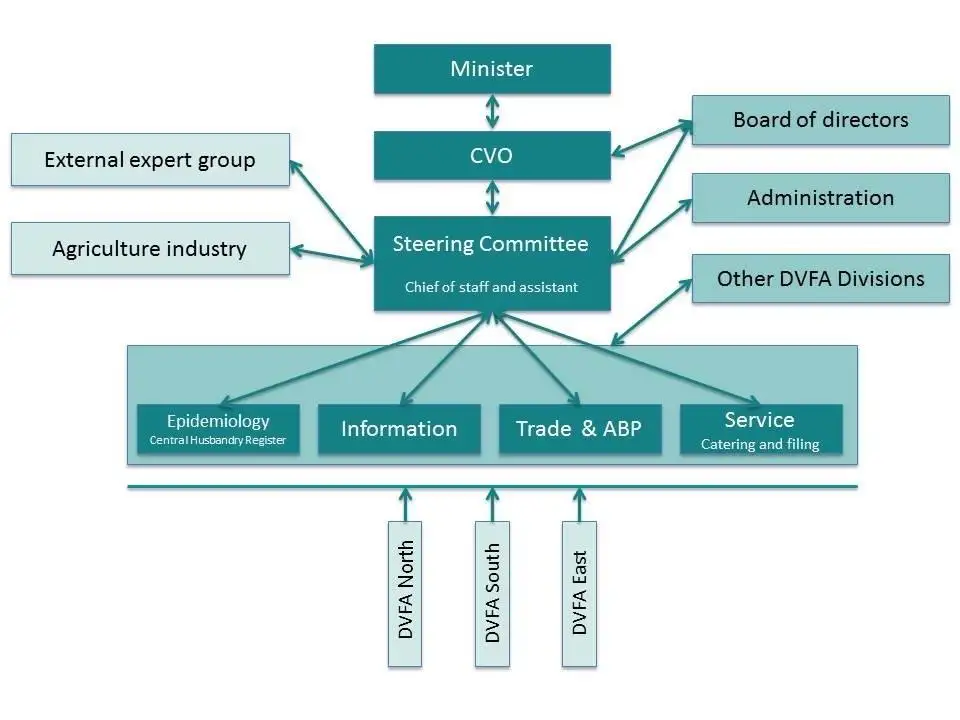The disease control organisation
In case of an outbreak of a serious animal disease, the Danish Veterinary and Food Administration (DVFA) may activate the veterinary disease control organisation. The Chief Veterinary Officer (CVO) is in charge of the strategic action during the disease outbreak. The Steering Committee with subgroups have the primary responsibility for the coordination and the overall management of the disease control.
The structure of the organisation is illustrated below.

The disease control organisation is based on a central and one or more local centres, the National Disease Control Centre (NDCC) and the Local Disease Control Centres (LDCC). Danish legal powers, financial provisions and the direct chain of command facilitate the response of the public administration to an outbreak of a notifiable disease. Plans are in place for the operation of the NDCC and the establishment of a LDCC.
In the event of an outbreak, the NDCC is first staffed by employees of the central offices of the DVFA, and the LDCC by employees of the relevant veterinary inspection unit VIU). The DVFA has three VIUs with local veterinary officers specifically trained in managing suspected cases and outbreaks of notifiable animal diseases.
Training
The veterinarians of the DVFA, including veterinarians of the VIUs, plan and prepare practical training in the contingency plans. The field staff are trained at seminars and targeted courses and by participation in simulation exercises.
Veterinary officers from the DVFA maintain their expertise in recognising the symptoms of specific notifiable diseases at the National Veterinary Institute, Technical University of Denmark. They are invited to observe the development of the diseases during research experiments performed by the Institute, e.g. experiments on pigs artificially infected with classical or African swine fever.
Simulation exercises
Simulation exercises constitute an important tool for testing contingency plans, but are also used for the training of DVFA staff and different stakeholders in handling emergency situations. Furthermore, exercises may be used for testing new equipment and procedures.
The Danish exercise programme comprises a number of exercises each year. The number is not fixed in advance, but depends on the animal health situation, including the number of real cases. Lessons learned from all exercises throughout the year as well as lessons learned from handling disease outbreaks are used to establish the most beneficial exercise programme for the following year.
The following categories of exercises are applied in the Danish training programme:
- Procedure exercises: Training in disease-handling procedures.
- Dilemma exercises: Desktop exercises to simulate a specific dilemma or train the use of new software.
- Crisis management exercises: Exercises with a broader scope, such as the assessment of resources, setting up of crisis centres, actions to control outbreaks, communication and collaboration between national or international partners as either local training or full-scale national simulation training involving both regional and national units.
- Evaluation seminars: Each year, the lessons learned from all exercises are evaluated. The learning obtained is used for updating contingency plans and internal procedures and is incorporated into the exercises the following year to create a multiplier effect.
Simulation exercises are conducted at regional level, at national level and, due to the close cooperation among the Nordic and Baltic countries (the Nordic-Baltic Veterinary Contingency Group), also as cross-border exercises at international level.
Full-scale exercises are conducted at intervals of 3-5 years, and extensive contingency exercises are carried out regularly for all eight Nordic and Baltic countries.
The exercises may involve a number of stakeholders, such as the National Reference Laboratory, the Danish Emergency Management Agency, the National Police, agricultural organisations, slaughterhouses and rendering plants.
In 2018, Denmark conducted procedure exercises at regional level and a crisis management exercise with the aim of developing and expanding crisis management skills. Further, the DVFA participated in several exercises planned and conducted by other organisations.